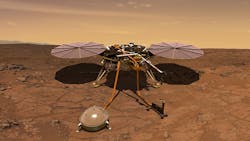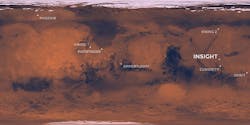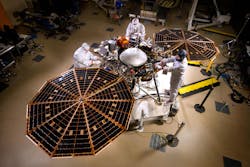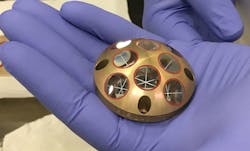NASA Seismic Probe Insight to Land on Mars
About six months after a picture-perfect launch from Vandenberg AFB atop a two-stage Atlas V 401 launcher, NASA’s Insight probe will be landing on Mars Nov. 26. The Atlas 401, which gets its 401 designation from having a four-meter diameter payload faring, no solid-rocket boosters, and one engine on the upper stage, has carried the Insight on a Type 1 trajectory to Mars. This means it will travel less than halfway around the Sun as it travels from Earth out to Mars.
The flight to Mars was planned so that no matter when the mission launched between May 5 and June 8, it would arrive on Nov 26 after its 205- or 171-day trip, respectively. During the flight, the probe will be checking and calibrating the subsystems and instruments, adjusting its altitude to keep the solar array and antennas pointed correctly, and make six scheduled trajectory adjustments using eight thrusters—four for fine-tuning the spacecraft’s flight path and four smaller ones to handle roll and attitude changes. There is also fuel for two contingency or back-up maneuvers.
Once on Mars, it will begin exploring the geology of the planet until the end of its mission on Nov 24, 2020, making it almost a two-year mission (or one Martian year plus 40 Martian days).
Insight’s Mission
The mission of NASA’s newest space probe lives up to its acronym of a name, Insight: Interior Exploration using Seismic Investigations, Geodesy, and Heat. Overall, its goals are to 1) understand the formation and evolution of terrestrial planets by investigating the interior structures and processes of Mars; and 2) determine the current levels of tectonic and meteorite impact activity on Mars.
To get to these goals, Insight will determine or measure:
- The thickness and structure of Mar’s crust.
- The composition and structure of its mantle.
- The size, composition, and physical state of its core.
- The thermal state of its interior.
- The rate and geographic distribution of any seismic activity.
- The rate of meteorite impacts on the surface.
This map of Mars shows the Insight landing site, as well as the landing sights of most other NASA Mars missions. Insight will land in the Elysium Planitia, a broad plain that straddles the planet’s equator. The site was chosen for its low elevation, giving the lander’s parachutes more atmosphere to grab on landing; its flatness, which simplifies the landing; and its proximity to the equator, where it will be warm and bright enough (Martian) year-round to keep the solar arrays and electronics working.
NASA equipped the lander with several instruments to pursue these goals. One of the major ones is a French-built seismometer to monitor and record ground vibrations. These could come from marsquakes (the Martian equivalent of earthquakes), meteor strikes, or the faint gravitational effects of Phobos, the moon that circles Mars. Its sensors will detect vibrations from one one-thousandth cycle per second up to 50 cycles per second. Besides detecting impacts and vibration, tracking the resulting seismic waves reveals much about the ground those waves travel through.
The spacecraft/lander was designed, built, and tested in Lockheed Martin Space’s Denver facility.
The lander’s radio will be in contact with the Earth to precisely track (within 4 in.) its position on Mars as it rotates throughout the course of an entire Martian year. This will let scientists determine the planet’s exact shape and orientation space and any variations in the rotational speed and any wobbles of its axis. The axis of rotation is sensitive to conditions deep inside Mars.
The three -legged Insight will land so that the two solar panels are aligned east to west and the seismometer and probe are on the ground and tethered to the south side of the lander. The Insight will be in the north hemisphere, so the probe’s shadow will never fall on and disrupt the sensitive instruments.
Finally, a German-made heat probe will be sunk more than10 ft into the ground to measure how well the ground conduct heat and how much heat is rising toward the surface. Heat sensors on the probe can measure temperature differences as small as 0.02°F. A spring-loaded tungsten block will hammer the probe down into the ground, taking an estimated 5,000 to 20,000 strokes at a stroke every 3.6 sec. Data from the probe will give astronomers a way to assess the planet’s interior energy and its dissipation.
Insight will also be studded with sensors that monitor wind speed and direction, variations in the magnetic field, changes in atmospheric pressure, and air and ground surface temperature. A robotic arm with two cameras will let Insight, under a little guidance from Earth, place the seismometer on the ground and pound the probe into the soil. Two other cameras will give Earthbound researchers a color look at the Martian countryside.
The national space agency of Italy (ASI, for Agenzia Spaziale Italiana) provided the laser retroreflector that will possibly be used on future Mars orbiter missions with a laser altimeter making extremely precise measurements of the lander’s location.
NASA is also planning ahead and putting a dome-shaped laser retroreflector atop the lander. It is not part of any Insight program but can be used by future Mars missions by giving orbiters a target for precise laser-altimeter readings. The retroreflector has eight reflectors, each containing three mutually perpendicular mirrors joined at one point, making it look like the inner corner of a box. This lets it bounce back any laser shined on it directly back at the source that sent it. Similar “corner cube reflectors” were left at landing sites on the Moon by Apollo astronauts. They have since been used for several experiments and measurements, including determining how much the distance between the Earth and Moon changes and how fast it changes, as well as to test Einstein’s general theory of relativity.
Mission Firsts
Insight will make several ‘firsts” on its two-year mission. In fact, it even set some before it ever got to Mars. Here are some of them:
First interplanetary launch from the West Coast. Long distance missions are usually launched eastward from NASA’s Cape Canaveral. This lets spacecraft use the momentum of the Earth’s eastward rotation. But the launch schedule was crowded at Cape Canaveral last year spring, so to keep things simple, NASA moved the launch to Vandenberg AFB in California. They relied on the Atlas V’s performance (850,000 lb of thrust) to launch the Insight on a more southerly initial trajectory and still have fuel to spare to get it to Mars, despite the lack of a boost from the Earth.
First mission dedicated to studying the interior of Mars. This also includes a couple other “firsts”: the first seismometer placed directly on another planet; the first time trying to detect quakes on another planet; and the first time burrowing a probe more than 10 ft beneath the surface of another planet.
First robotic arm to grab and manipulate tools and instruments on another planet. The arm will place the seismometer on the surface then use the burrowing tool to send the probe more than 10 ft beneath the surface.
MarCO cubesats were designed and built at NASA’s JPL. It is the same lab that designed the first U.S. satellite, Explorer 1, which discovered the Van Allen radiation belts in 1958. It was not unlike the MarCO, a small, rudimentary-but-capable spacecraft.
First use of CubeSats on an interplanetary mission through deep space. Two Mars Cube Ones (MarCO) spacecraft, each measuring 14.4 × 9.5 × 4.6 in., were launched on the same rocket that took Insight into space. These briefcase-sized CubeSats are now travelling a few thousand miles or so behind Insight on their own trajectories under their won propulsion and steering. They each carry high-gain antennas and a compact radio, enabling them to communicate with Earth from up to 93 million miles away. The Cube Ones will be relaying data from Insight to Earth during probe’s the descent and landing phases. They also have cameras and can take and send images during the flight. One of the first images snapped was of the Earth and Moon as the MarCO left on its trip to Mars.
NASA will provide coverage of the Inflight landing on its website. For details, click here.







